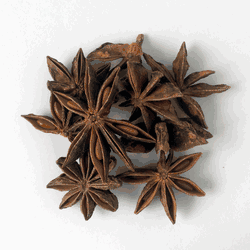The NEW website is at www.bluemonkeytea.com, NOT here. Blue Monkey Tea Pittsburgh
Blue Monkey Tea Pittsburghhttps://bluemonkeytea.com/

Whole Star Anise Loose Herbal Tea
An unusual, star-shaped spice, star anise adds pungent, licorice-like flavor and aroma to meats, stews, mulled beverages and liqueurs.
Botanical name: Illicium verum Hook. f.
Star anise is also an essential ingredient in blends like five spice and garam masala--and it makes a lovely addition to potpourri.
Star anise is the distinctive fruit of an evergreen tree, Illicium verum. Related to the magnolia, it has a whitish, aromatic trunk and grows to about 26 feet. The star anise is the unripe fruit that's been picked and dried. It's sold both whole and ground into an aromatic, red-brown powder. It's also known as anise star, takkola, and Chinese star anise.
The Chinese name for star anise means eight points, and most of the specimens do have eight carpels, or points (though you can find star anise with as few as five and as many as 12 points). Each of the carpels forms a little capsule with one single brown seed inside. Japanese star anise (Illicium anisatum) is not the same plant. In fact, it's toxic and is used primarily for incense.
Star anise is a source of shikimic acid, which is used to produce the anti-flu drug tamiflu. It also contains anethole, which give both star anise and anise their licorice-like flavor. A bit stronger than anise seed, this intriguing spice is often used in Chinese and Vietnamese cooking. Chinese star anise has been used as a spice and medicine for over 3000 years. The genus name is thought to come from the Latin illicium, which means allurement, a reference to the sweet aroma of the fruits. The English navigator Sir Thomas Cavendish brought star anise to Europe via the Philippines in 1578.
Suggested Uses: The aroma of star anise is strong and licorice-like, more pungent than anise seed, but similar. Its flavor is like anise, but slightly harsher and more bitter. Star anise is very popular in Chinese dishes, though it can be found in other cuisines as well-- like South Vietnamese, Indonesian, Indian, and Malaysian. It's used in Vietnamese noodle soup, and in Thailand you'll find it flavoring an iced black tea. In India it's an important ingredient in curry powder and garam masala blends, while in China it's a crucial ingredient in five spice powder, stocks and stews, with beef and chicken, and in marbled eggs (an hors d'ouevre). The Mandarin Chinese often chew the fruit whole as a breath freshener. Star anise is also used to flavor liqueurs like anisette and pernod. Try star anise in meat and poultry dishes (especially pork, duck, and chicken), soups and stocks, and with fruits and compotes. Include it with other whole spices for mulling wine and cider.
Indigenous to eastern China and northeastern Vietnam, star anise is now widely cultivated in Spain, France, Italy, Morocco, China, India, the Philippines, Jamaica, and Laos. China and Vietnam are the world's major producers, though.